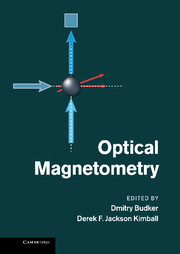Book contents
- Frontmatter
- Contents
- List of contributors
- Preface
- Part I Principles and techniques
- Part II Applications
- 13 Remote detection magnetometry
- 14 Detection of nuclear magnetic resonance with atomic magnetometers
- 15 Space magnetometry
- 16 Detection of biomagnetic fields
- 17 Geophysical applications
- Part III Broader impact
- Index
13 - Remote detection magnetometry
from Part II - Applications
Published online by Cambridge University Press: 05 May 2013
- Frontmatter
- Contents
- List of contributors
- Preface
- Part I Principles and techniques
- Part II Applications
- 13 Remote detection magnetometry
- 14 Detection of nuclear magnetic resonance with atomic magnetometers
- 15 Space magnetometry
- 16 Detection of biomagnetic fields
- 17 Geophysical applications
- Part III Broader impact
- Index
Summary
Introduction
Shortly after the inception of atomic magnetometry, alkali-vapor magnetometers were being used to measure the Earth's magnetic field to unprecedented precision. During the same era, Bell and Bloom first demonstrated all-optical atomic magnetometry through synchronous optical pumping [1] (see Chapters 1 and 6). In this approach, optical-pumping light is frequency- or amplitude-modulated at harmonics of the Larmor frequency ωL to generate a precessing spin polarization within an alkali vapor at finite magnetic field [2, 3]. Although this technique received considerable attention from the atomic physics community for its applicability to optical pumping experiments, Earth's-field alkali-vapor atomic magnetometers continued to rely on radiofrequency (RF) field excitation for several decades (see Chapter 4). Upon the advent of diode lasers addressing alkali and metastable helium transitions, synchronously pumped magnetometers experienced a revival beginning in the late 1980s. In recent years, such magnetometers have found applications in nuclear magnetic resonance detection [4] (see also Chapter 14), quantum control experiments [5], and chip-scale devices intended for spacecraft use [6] (see also Chapters 7 and 15).
All-optical magnetometers possess several advantages over devices that employ RF coils. RF-driven magnetometers can suffer from cross-talk if two sensors are placed in close proximity, since the AC magnetic field driving resonance in one vapor cell can adversely affect the other. All-optical magnetometers are free from such interference. When operated in self-oscillating mode [7], RF-driven magnetometers require an added ±90° electronic phase shift in the feedback loop to counter the intrinsic phase shift between the RF field and the probe-beam modulation.
- Type
- Chapter
- Information
- Optical Magnetometry , pp. 251 - 264Publisher: Cambridge University PressPrint publication year: 2013



